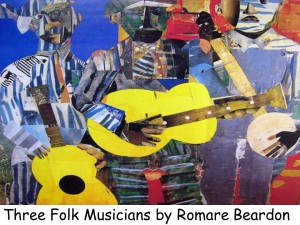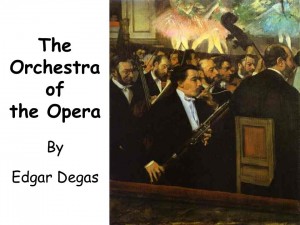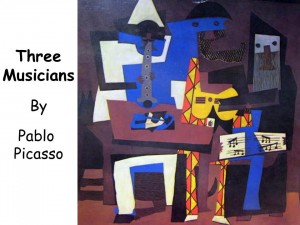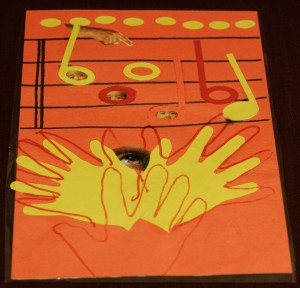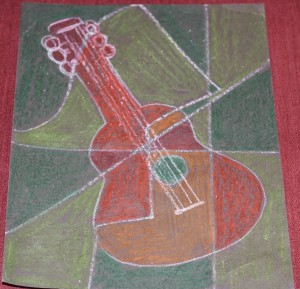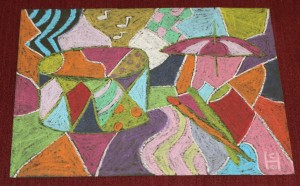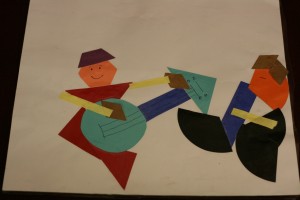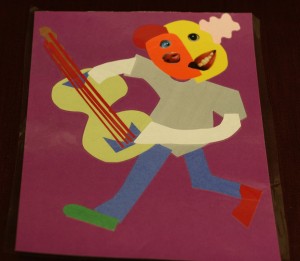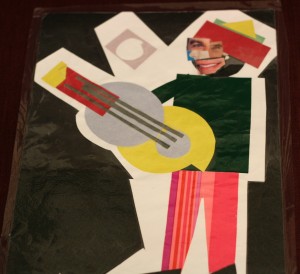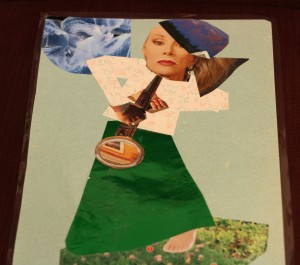1.
2.
3.
4.
5.
6.
The most REALISTIC painting in this packet is The Orchestra of the Opera by Edgar Degas. Ikon Hands is a RELIEF SCULPTURE, as well as an EXPRESSIONISTIC painting.
The other paintings are EXPRESSIONISTIC (they don’t look like something natural). Expressionistic artists care more about the emotion and feeling they express in their work (the MOOD) than the REALISM. The paintings by Bearden, Chagall, Johnson and Picasso are filled with LINE, COLOR, SHAPE and lots of PATTERN.
Be sure ALL 6 pictures are returned to the Packet Carrier after your Presentation is finished.
Green Violinist
Painted 1923-24
By Marc Chagall—Russian artist
About the Artist
Marc Chagall was born Moishe Shagal on July 7, 1887 in a small village in Russia. His Jewish parents were very poor. In those days Czars ruled Russia. The czars persecuted Jews and forced them to live in restricted villages called shtetls. Many of Chagall’s happiest and most magical paintings are based on memories of his village or shtetl.
Chagall spent World War I in Russia. In 1915, he married Bella. In 1922, he left Russia for good. First, he and Bella went to Berlin, Germany and then to Paris, in 1923. In 1941, Chagall settled in the United States. In 1944, his beloved wife, Bella died. He stayed in the U.S., until 1947, when he returned to Paris.
Marc Chagall died in 1985, at the age of 97
About the Art
Based on memories of his childhood in the shtetl, Chagall created murals, stage sets and costumes for the State Jewish Chamber Theater, in Moscow, Russia. When he moved to Paris, France in 1923, Chagall made this version of the Green Violinist. It was originally painted for the theater, to symbolize the art of music.
Chagall’s fiddler plays high above the village rooftops. Chagall created the musician’s coat in hard-edged purple and lavender shades.
Can you see how the artist sectioned the coat with purple and lavender triangles and zigzags? Chagall created a theatrical effect by using bright green paint for the violinist’s face and one of his hands.
Chagall painted lively designs, based on GEOMETRIC SHAPES, all through this composition (an artistic product—a painting). What GEOMETRIC SHAPES are REPEATED in the picture? Squares, such as the little windowpanes in the houses, are repeated in the pattern on the fiddler’s trousers. Triangles form the peaked roofs and the zigzag folds of the fiddler’s purple coat.
Can you find the person floating happily among the circular clouds?
Almost fifty years after this picture was painted, Chagall’s painting once again came to life in the theater. The sets and costumes for the 1964 Broadway musical, Fiddler on the Roof, were based on this painting.
What do you notice about the fiddler’s shoes? Like the hands, they are not both the same color.
What type of MOOD does this picture create? Crazy, happy, funny, goofy might describe the mood for some
HERE’S SOME FUN IDEAS!
• Check out the video “Fiddler on the Roof’ and show the opening scenes with the fiddler dancing across the rooftops.
• Some musicians have tried to capture the mood of a painting in a piece of music. The most famous example of this is Modeste Mussorgsky’s “Pictures at an Exhibition”. The music describes walking around an art gallery and looking at the paintings. As the viewer stops in front of each painting, the music changes to represent what is found in the picture. Listen to this music and draw (or paint) your idea of what each painting might have looked like. Pay attention to the music, to get an idea of the MOOD of the picture. Discuss the types of MOODS that certain colors might convey, before beginning. Some of the music sections may need to be listened to more than once. After everyone is finished, play the music again and have the kids hold up the pictures they have created for each section of the music each time the music changes. It will be interesting to compare the pictures. Remind kids that there is no wrong way to do this activity. They are only supposed to create what the music makes them FEEL.
Street Musicians
William H. Johnson—American artist
Painted about 1940
About the Artist
William H. Johnson was an African-American painter who received his formal training at the New York Academy of Design. Early in his career, he worked in a style inspired by the great modern European painters, such as Vincent van Gogh. After a 1932 visit to Africa, where he explored his ancestral legacy, Johnson developed what he called a “primitive” style of painting to express his feelings about the black experience.
About the Art
This painting portrays two sidewalk entertainers performing for spare change. With a few lines, Johnson captured a note of sadness in the faces of this couple, who appear as struggling to make ends meet.
What types of LINE do you see in the picture? Diagonal or (Grades 4-5) cross-hatched
The background suggests the crisscross black lines of a sidewalk, as it might look from an upstairs window. By combining this aerial view of the sidewalk with an eye-level view of the couple, Johnson suggests the MOOD of a constantly changing street scene.
The couple is the FOCAL POINT or CENTER OF INTEREST in this picture. Johnson has painted a very simple background so that our eyes will focus on the two musicians.
Johnson brought a special insight to being a black American through the themes that he chose to paint.
Do these musicians look realistic? They are created in a Folk Art style, which is EXPRESSIONISTIC
Johnson has created colorful, almost “cartoonish” characters. The characters are flat, which means there is no shading or highlighting. He didn’t want them to be anyone specific. The couple represents a “group” of people.
The artist wanted to express emotion and feeling. He never tried to make the musicians look realistic or lifelike. Although he was a professionally trained artist, Johnson chose to make his people look as if a FOLK ARTIST or PRIMITIVE ARTIST painted them. (This is what an artist with no professional training is called.) He created a feeling that these musicians are just ordinary simple people, playing music on an ordinary city street. It was probably a scene Johnson saw many times while living in New York City.
What COLORS did the artist use in the painting? Is there any REPETITION in the COLORS the artist chose? Woman’s hat, guitar, and the man’s tambourine are Yellow; Red guitar edge, man’s tie; Turquoise—woman’s skirt, container held under the man’s arm; Orange—woman’s jacket, edge of man’s tambourine; Black—shoes, woman’s hatband, man’s clothing (part of it), man’s hat; Royal Blue—man’s hatband, man’s left sleeve, right pant leg, left front of his jacket, woman’s guitar; Brown—the skin of the musicians; both wear White shirts
The artist has repeated every COLOR.
Are there any REPEATED SHAPES? Buttons, fingernails, shoes, guitar “tuning pegs” are all examples of REPETITION
Project Idea
• Use color crayons to create a simple, EXPRESSIONIST picture of a musician, or several musicians, playing instruments. Try to copy William Johnson’s “primitive” or “folk art” style. Push hard on the crayons to make your colors bright. Create a CENTER OF INTEREST with the musician(s) by using a simple pattern of LINE or COLOR in the background. Remember—you don’t want the musician(s) to look lifelike.
Three Folk Musicians
Romare Bearden—American artist
Painted 1967
About the Artist
Romare Bearden was an African-American painter who was born September 2, 1914, in Charlotte, North Carolina. He was an only child and grew up mostly in the South. When Romare was still young, the family moved to Harlem, in New York City.
Bearden received a Bachelor of Science degree from New York University because, he said, “I thought I wanted to be a medical doctor.” But later, his association with African American artists during the Depression period encouraged Romare to become an artist himself. One of these influential artists was Jacob Lawrence.
About the Art
During visits with his grandmother in Lutherville, Maryland, young Bearden listened to the blues guitar of a local musician named E. C. Johnson. In this collage painting, Bearden paints the country blues, a musical form that evolved from the percussive rhythms of West African work songs and from the Scotch-Irish folk songs. Blues music is a ballad (story) of love and loss.
The mild-mannered, almost shy artist insisted that he was not a social propagandist. “My subject is people,” he said. “They just happened to turn out to be Negro.” (This was a “politically correct” term for people of African American descent in the 1950s and 1960s.) Bearden created the everyday people he saw in the world, using his own unique style of art. His paintings of everyday black life were forceful and bright in color. The people were created following simple patterns of line and shape.
By 1960, Bearden’s personal style had firmly caught the imagination of the art world. Drawing on his boyhood memories of the Deep South, and his experiences as a longtime resident of Harlem, he showed the conditions in which African Americans lived with such stark reality that the collage or montage became a powerful art form. In other words, his simply painted and childlike depictions of black people created a very moving and powerful statement to the world. His unusual medium, collage, was also a new artistic style and Bearden’s art helped it become more acceptable to traditional art audiences. Bearden used his imagery to discuss all aspects of the American black experience—the civil rights movement of the 1960’s, the rhythms of black music and memories of the customs of the black South he had grown up in.
Bearden created this musical trio by gluing together colored paper and fragments of photographs from magazines. This is a technique called collage. He carefully arranged eyes, noses and hands cut out of magazines, along with pieces of painted paper to shape the people. Bearden focused attention on the musician’s eyes and hands by deliberately using images that are too large in proportion to people. Why do you think the artist made the musician’s eyes and hands so large? The answer is a matter of various opinions, maybe he wanted the viewer to focus on the instruments, which each of their hands are touching, maybe the artist thought we would be able to see the faces of the musicians better, maybe the artist felt these were things that just made the entire picture more interesting (all theories are probable) Was it important to the artist for the musicians to appear life-like and natural? Obviously not, they are abstract and expressionistic, they are also posed stiffly
Bearden then applied strokes of blue and green paint over the assembled cutouts to create an even blue-gray tone in the musicians’ faces and clothes. He glued patterned scraps of paper to the background and created a field with a little orange moon, rising over the faraway hills. Can you find the moon? In the upper left corner
Project Idea
• Create a collage of a musician or musicians with their instruments. Wrapping paper and wallpaper scraps will make interesting and colorful designs for clothing. Paint PATTERNS on pieces of paper, let dry and cut out clothing. These painted pieces could have several painted designs to cut from. Some construction paper could also be used. Catalogues and fashion magazines could be used to cut out eyes, noses and hands in the same way Bearden did.
• Create a musical instrument using cut paper, wrapping paper or wallpaper. Have kids create the entire instrument using ONLY cut paper—no drawing! Glue to a solid background. Discuss the types of instruments to create and ways to create them. The collages will be more interesting, and look more like a Bearden creation, using more than one solid piece of paper to create the instrument. Notice how Bearden’s guitars are created like a mosaic, using different shaped pieces of yellow paper glued closely together. Bring in prints and photos of musical instruments for inspiration.
The Orchestra of the Opera
Edgar Degas (Duh GAH)—French artist
Painted about 1870
About the Artist
Edgar Degas (Duh GAH) was born July 19, 1834, in Paris, France. He was the son of a well-to-do banker. From an early age, Edgar loved books and was a very serious, hardworking student. His father wanted him to study law but he enrolled in Art school in 1855.
In 1856, Degas went to Naples, where his sister lived, and eventually settled in Rome for 3 years. In Rome, he studied the Renaissance Masters and fresco painting. In 1861, Degas went back to Paris.
From 1862-1870, Degas painted portraits of his friends and family. From 1873-1883 Degas produced many paintings and pastels of the racecourse, music hall and the ballet. He established himself with a fine reputation as an artist and had no financial problems like many of his other artist friends.
Degas stopped exhibiting at the respected Paris *Salon in 1874 and displayed his works with the impressionists until 1886. (*See packet 4. Monet)
Beginning in the middle 1870’s, Degas suffered from failing eyesight. In the 1890’s, he became more and more of a recluse. In the last years of his life, Degas was almost totally blind. He died September 27, 1917, in Paris, France.
About the Art
The magnificent scale of the opera captivated Edgar Degas. He enjoyed the music, drama, song and ballet performed in a grand theater. The opera was performed for wealthy people.
What is the FOCAL POINT (the most important thing) of the painting? What did the artist want us to pay attention to the most? The musician (bassoonist) in the FOREGROUND of the painting
This painting is really a portrait of Désiré Dihau, the orchestra’s bassoonist. He is the musician in the center FOREGROUND. This picture was very controversial at the time it was painted. Instead of painting a formal portrait of a classical artist surrounded by objects that symbolize his talent and intellect, Degas painted Dihau as a working musician—something that was just not done in those days.
In this painting, Degas captured the excitement of being in the front row during a performance. There is so much activity that it is difficult to focus attention on any one person. Some of the members of the orchestra seem clear and precisely detailed. Others are blurred impressions of light, movement, color and texture.
Degas focuses attention on the orchestra through the contrast between the colors and the detail with which he painted the musicians, who are uniformly dressed in black evening clothes, and the vibrant blur of pastel brushstrokes that suggest the twirling ballerinas onstage. Degas cut off the dancers’ heads, to create a sense of the distance from the bassoonist to the stage, while the carved top of the bass, called a scroll, visually connects the musicians with the performance.
The Orchestra of the Opera was exhibited only once during Dega’s lifetime, then disappeared from public view until 1935. Today it is considered one of Degas’ masterpieces.
What type of dancers do you see? Ballet dancers Although their heads were not included in the painting, can you find the dancers in the BACKGROUND?
Project Idea
• Edgar Degas was also a sculptor. Use clay to create a sculpture of a musician.
• Display the bronze sculpture by Degas of a ballerina interartex.com/_wsn/page3.html entitled “Little Dancer Age Fourteen”. In February, 2009, this sculpture sold for $30 million dollars and is believed to be one of Degas best examples of sculpture. This artist loved to paint MOVEMENT and he loved to paint and sculpt ballerinas because of their graceful movements when dancing. Create a sculpture of a dancer, gymnast, or acrobat. Show MOVEMENT in your sculpture.
• A project based on MOVEMENT could be a drawing or painting of a person dancing (does not need to be a ballerina). Discuss with the class the ways an artist might show MOVEMENT in a person dancing—curved and angled LINE created by body position, arms, legs, hair, ribbons, clothing, etc. Use PATTERN, COLOR and/or LINE to create an interesting and contrasting BACKGROUND for the dancer. Suggestions for types of dancers: Square dancer, tap dancer, hula dancer, folk dancer (chance to illustrate costumes from many countries), trapeze artist, gymnast
Three Musicians
Pablo Picasso—Spanish artist
Painted 1921
About the Artist
Pablo Ruiz Picasso was born in Malaga, Spain, in 1881. His father was an art teacher at the local school. He encouraged his son to paint and draw. He wanted Picasso to become a great artist some day. Picasso showed a very early talent for drawing. He studied art, traveling to Paris to learn the styles of the Impressionists. In 1904, he settled into Paris, where he remained for the rest of his life.
Pablo Picasso is often called the first modern painter of the twentieth century because he constantly searched for new and innovative ways to express his creativity. Inspired by his love of African masks and primitive sculpture, Picasso often depicted people as objects made up of geometric shapes–squares, circles, triangles and rectangles. Art critics labeled Picasso’s abstract art style CUBISM.
Picasso’s enormous talent, imagination and vitality add up to an artistic temperament that can be called genius.
About the Art
In this painting, Picasso constructed a musical trio out of hard-edged shapes, using strong colors and bold PATTERN designs. He flattened the forms of a rod like clarinet, a banana-shaped hat and a cube-shaped room. Picasso projected black shadows of the musicians against the background. This creates a sense of distance from the musicians to the rear wall. The solid black shadows contrast the COLORS and TEXTURES of the musicians and give the feeling of afternoon light fading into darkness. Picasso brought a spirit of fun to this painting.
Suggested Dialogue
Notice how all of the faces look like they have on masks.
Can you find the guitarist? He is wearing the diamond-patterned suit.
What is the musician on the left doing? Playing a clarinet or a recorder
Can you find the singer? On the far right
Can you see the sheet music?
How many SHAPES, COLORS and PATTERNS can you find in each of the faces? Mostly GEOMETRIC SHAPES create the faces, Musician in center has a cross-hatched LINE pattern for his beard, Musician on far right has curved LINE or hatched PATTERN for his beard
Where else do you see PATTERN? Short lines of dog’s fur create random pattern, diamonds or triangles create GEOMETRIC pattern, the circles on the clarinet create pattern
Can you see a table? Can you find a dog? On the left side of the picture, you can see his head on the wall and his body is under the table and the first musician
Project Idea
• Create a musician, musicians, and/or singer(s), using cut construction paper in rectangle, triangle and square SHAPES, glued together like a mosaic. Create heads from several shapes and colors glued together. This Style of art, breaking images down into geometric shapes, is called CUBISM.
Ikon Hands
Larry Rivers—American artist
Painted 1988
About the Artist
Larry Rivers was born August 17, 1923. He hoped to make it as a musician and studied piano and later the saxophone. At the age of eighteen he became a professional saxophone player. Rivers performed with several jazz bands but interrupted his musical career by enlisting in the U.S. Army Air Corps. His military service was cut short by a nervous disorder that forced him to return to civilian life. He resumed his musical career and studied at the Juilliard School of Music in 1944 and 1945.
The year 1945 was a turning point for Rivers. The wife of a fellow band member, Jane Freilicher, was an artist. While touring with a band in Old Orchard, Maine, Larry began to paint. Jane recognized his talent and encouraged his painting. Though he continued to support himself as a musician, Rivers’ interest in painting grew. Rivers soon realized that his true talent lay in painting, not in jazz. He studied painting with other artists from 1946-1948. In 1948, Rivers studied art at New York University, with the hope of eventually teaching it himself.
In 1950, Rivers went to Paris for eight months, to study art. During the 1950’s and 1960’s, he painted, played as a jazz musician, and was a writer, a filmmaker and actor. In 1972, he taught at the University of California, in Santa Barbara. Rivers is an internationally recognized painter today and continues to find time to play the saxophone in the East 13th Street Jazz Band.
About the Art
With IKON HANDS, Rivers chose a close-up view to symbolize the legendary Charlie Parker who was widely considered one of the greatest jazz musicians of the twentieth century. Rivers captured the ease with which the musician’s long elegant fingers span the saxophone keys.
Rivers combined painting, drawing and sculpting to make this relief image. This picture projects out from the background. He first made a charcoal drawing on canvas, which he cut into three pieces. The background includes the neck of the instrument and its straps. It is mounted onto a wooden frame for stability. He glued the player’s hands onto a lightweight panel called foam board. This was then glued on top of the saxophone. The bell-shaped horn of the saxophone is also mounted on foam board and mounted in front of the hand in the foreground of the picture. The saxophone player’s left hand seems to be pushing out of blue strips of color that have been mounted on foam core board and attached on top of the hand in the picture.
Rivers then sealed the canvas with a white base coat called gesso that allows the charcoal drawing to show through. He then painted with semi-transparent oil paint and used the lines and shading of the charcoal drawing underneath to show through and work with the finished painting.
Can you see any REPEATED SHAPES? Fingers, circles of saxophone keys (these create the musical sounds)
Are there any DIAGONAL LINES? Yes, the saxophone strap (left) and the saxophone (center), lines of some of the fingers (the lines of the other fingers are HORIZONTAL)
Project Idea
• Paint a close up of a musical instrument on a piece of tag board or cardboard. The hands playing the instrument could be drawn on a piece of corrugated cardboard or foam board. They should then be cut out, painted and glued on the background painting, to look like the hands are playing the instrument and project in front of the instrument. You might also want to include the arms with the hands. This painting will then be a RELIEF SCULPTURE, just like the picture Larry Rivers has created here.
• Bring in a portable keyboard. Create a close up view of hands playing on the keyboard. The piano keys and the hands should fill the ENTIRE picture, FOREGROUND and BACKGROUND! Pose for the class as they draw your hands.
Blowing Cold
What did the musician do when
Someone put his trumpet in the freezer?
He played it cool!
—Roy Doty
Did you know that March is Music in our Schools month?
Orchestra
So you haven’t got a drum,
Just beat your belly.
So I haven’t got a horn—Ill play my nose.
So we haven’t any symbols—
We’ll just slap our hands together
And though there may be orchestras
That sound a little better
With their fancy, shiny instruments
That cost an awful lot—
Hey, we’re making music twice as good
By playing what we’ve got!
—Shel Silverstein
There are all kinds of “body percussion” sounds. Here are just a few the class could try together as you lead them, using various RHYTHMS:
Rub palms together in a circular motion; slap thighs; stamp feet; slide feet; snap fingers; slide hands down sides; clap hands; brush knees in a side-to-side motion; pat knees; cluck with tongue to roof of mouth while making different shapes with lips; clap cheeks while alternately opening and closing lips into “O” shape, smack lips together
K-1 students especially enjoy this action activity!

